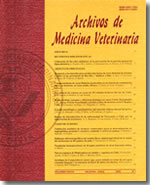Haemopoyetic neoplasm in 10 cats positive to feline leukaemia virus
Main Article Content
Abstract
Presence of the antigen of the feline leukaemia virus in serum of cats naturally infected was observed in Chile in 1989, using an ELISA test. This virus induces neoplastic as well as non-neoplastic alterations. The lymphoproliferative neoplasms are more common than the myeloproliferative haemopoyetic neoplasms. Haemograms and myelograms stained with Giemsa and cytochemical stains were used for the diagnosis of the altered cellular line.
The objective of this investigation was to contribute to the knowledge of the haemopoyetic neoplastic diseases of cats positive to the virus.
Ten cats positive to the feline leukaemia virus and with clinical signs were used. Samples of blood and bone marrow were processed with both stains. The cytochemical stains used were peroxidase, the naphthol AS-D chloroacetate esterase and the alpha naphthyl acetate esterase. Four healthy cats, negative to the virus were used as a control group.
The haemograms and myelograms results showed that 7/10 were lymphoma, 3 of them also presented alterations in the neutrophilic granulocytic cells; 2/10 presented erythremic myelosis and 1/10 eosinophilic leukaemia.
Blood cells stained with peroxidase and naphthol AS-D chloroacetate esterase were higher in number in the positive cats than in the control group, which indicates the existence of a larger number of immature cells in blood. The results regarding bone marrow, were similar in positive and control cats.
The diagnoses of haemopoyetic neoplasms were confirmed by the severity of anemia, the presence of immature cells in blood and the larger amount of cells positive to the different cytochemical stains.

